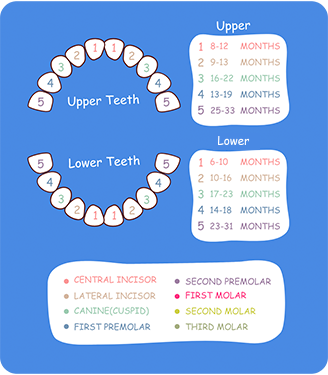Your Child's Teeth
Baby Teeth

A child's primary teeth, sometimes called “baby teeth”, are as important as the permanent adult teeth. Primary teeth typically begin to appear when a baby is between age six months and one year. Primary teeth help children chew and speak. They also hold space in the jaws for permanent teeth that are growing under the gums. The ADA recommends that a dentist examine a child within six months after the first tooth comes in and no later than the first birthday. A dental visit at an early age is a “well baby checkup” for the teeth. Besides checking for tooth decay and other problems, the dentist can show you how to clean the child's teeth properly and how to evaluate any adverse habits such as thumb sucking.
The Teething Cycle
When teeth first come in, some babies may have sore or tender gums. Gently rubbing your child's gums with a clean finger, a small, cool spoon or a wet gauze pad can be soothing. You can also give the baby a clean teething ring to chew on. If your child is still cranky and in pain, consult your dentist or physician. Most children have a full set of 20 primary teeth by the time they are three years old.
Keeping Your Child's Teeth Healthy
Begin cleaning the baby's mouth during the first few days after birth. After every feeding, wipe the baby’s gums with a clean gauze pad. This removes plaque (a sticky film of bacteria) and residual food that can harm erupting teeth.
As soon as teeth appear in the mouth, tooth decay can occur. Therefore, when your child’s teeth begin to erupt, brush them gently with a child’s size toothbrush and water. Brush the teeth of children over age two with a pea-sized amount of fluoride toothpaste. Be sure they spit out the toothpaste and rinse with water. (Ask your child’s dentist or physician if you are considering using fluoride toothpaste before age two.) Infants should finish their bedtime and naptime bottle before going to bed. If you use a pacifier, use a clean one. Never dip a pacifier in sugar or honey before giving it to a baby. (Ask your child’s physician or dentist to recommend a type of pacifier.)
Teeth Development

Most people have two sets of teeth during their life: the primary or “baby” teeth and the permanent or “adult” teeth.
The 20 primary teeth that will appear during the first 3 years of life are present at birth in the baby’s jawbones. Baby teeth are important in normal development for chewing, speaking and appearance. The baby teeth also hold the space in the jaws for the permanent (adult) teeth. Primary teeth may be temporary but they need good care for many years.
From around age 6 to age 12, children will lose their baby teeth and the adult teeth will appear. The first adult teeth to come in are the first permanent molars. The first permanent molars are especially important because they help determine the shape of the lower face and affect the position and health of other permanent teeth. The last teeth to appear are the third molars or “wisdom teeth” at around age 17 – 21 years. By age 21, all 32 of the permanent teeth have usually appeared.
Teeth vary in size, shape and their location in the jaws. These differences enable teeth to work together to help you chew, speak and smile. They also help give your face its shape and form. It is important to protect the adult teeth for a lifetime by brushing twice a day with a fluoride toothpaste, by cleaning between the teeth once a day with floss or an interdental cleaner and by visiting a dentist regularly.
Wisdom Teeth
Wisdom teeth are a valuable asset to the mouth when they are healthy and properly positioned. Often, however, problems develop that require their removal. When the jaw isn’t large enough to accommodate wisdom teeth, they can become impacted (unable to come in or misaligned). Wisdom teeth may grow sideways, emerge only part way from the gum or remain trapped beneath the gum and bone.
Extraction of wisdom teeth is generally recommended when:
Wisdom teeth only partially erupt. This leaves an opening for bacteria to enter around the tooth and cause an infection. Pain, swelling, jaw stiffness and general illness can result. There is a chance that poorly aligned wisdom teeth will damage adjacent teeth. A cyst (fluid-filled sac) forms, destroying surrounding structures such as bone or tooth roots. Patients should ask the dentist about the health and positioning of their wisdom teeth. The dentist may make a recommendation for removal or send the patient to an oral surgeon for further evaluation.